2017 NISSAN ROGUE light
[x] Cancel search: lightPage 509 of 547
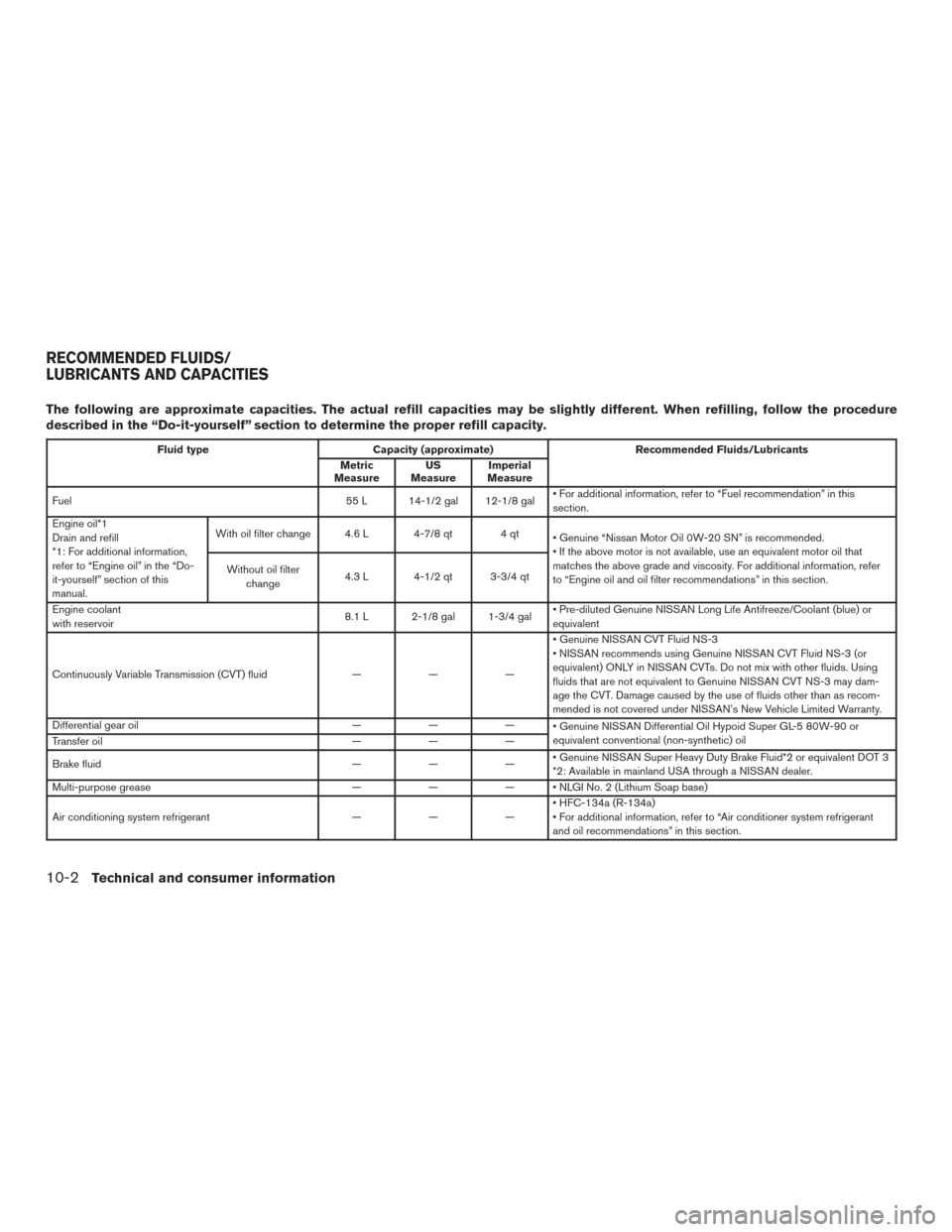
The following are approximate capacities. The actual refill capacities may be slightly different. When refilling, follow the procedure
described in the “Do-it-yourself” section to determine the proper refill capacity.
Fluid typeCapacity (approximate) Recommended Fluids/Lubricants
Metric
Measure US
Measure Imperial
Measure
Fuel 55 L 14-1/2 gal 12-1/8 gal• For additional information, refer to “Fuel recommendation” in this
section.
Engine oil*1
Drain and refill
*1: For additional information,
refer to “Engine oil” in the “Do-
it-yourself” section of this
manual. With oil filter change 4.6 L 4-7/8 qt 4 qt
• Genuine “Nissan Motor Oil 0W-20 SN” is recommended.
• If the above motor is not available, use an equivalent motor oil that
matches the above grade and viscosity. For additional information, refer
to “Engine oil and oil filter recommendations” in this section.
Without oil filter
change 4.3 L 4-1/2 qt 3-3/4 qt
Engine coolant
with reservoir 8.1 L 2-1/8 gal 1-3/4 gal• Pre-diluted Genuine NISSAN Long Life Antifreeze/Coolant (blue) or
equivalent
Continuously Variable Transmission (CVT) fluid ———• Genuine NISSAN CVT Fluid NS-3
• NISSAN recommends using Genuine NISSAN CVT Fluid NS-3 (or
equivalent) ONLY in NISSAN CVTs. Do not mix with other fluids. Using
fluids that are not equivalent to Genuine NISSAN CVT NS-3 may dam-
age the CVT. Damage caused by the use of fluids other than as recom-
mended is not covered under NISSAN’s New Vehicle Limited Warranty.
Differential gear oil ———
• Genuine NISSAN Differential Oil Hypoid Super GL-5 80W-90 or
equivalent conventional (non-synthetic) oil
Transfer oil ———
Brake fluid ———• Genuine NISSAN Super Heavy Duty Brake Fluid*2 or equivalent DOT 3
*2: Available in mainland USA through a NISSAN dealer.
Multi-purpose grease ——— • NLGI No. 2 (Lithium Soap base)
Air conditioning system refrigerant ———• HFC-134a (R-134a)
• For additional information, refer to “Air conditioner system refrigerant
and oil recommendations” in this section.
RECOMMENDED FLUIDS/
LUBRICANTS AND CAPACITIES
10-2Technical and consumer information
Page 513 of 547

Incorrect ignition timing may result in spark
knock, after-run and/or overheating, which may
cause excessive fuel consumption or engine
damage. If any of the above symptoms are en-
countered, have your vehicle checked. It is rec-
ommended that you visit a NISSAN dealer for
servicing.
However, now and then you may notice
light spark knock for a short time while
accelerating or driving up hills. This is not a
cause for concern, because you get the
greatest fuel benefit when there is light
spark knock for a short time under heavy
engine load.
ENGINE OIL AND OIL FILTER
RECOMMENDATIONS
Selecting the correct oil
It is essential to choose the correct grade, quality
and viscosity engine oil to ensure satisfactory
engine life and performance. For additional infor-
mation, refer to “Recommended fluids/lubricants
and capacities” in this section. NISSAN recom-
mends the use of an energy conserving oil in
order to improve fuel economy.
Select only engine oils that meet the American
Petroleum Institute (API) certification or Interna-
tional Lubricant Standardization and ApprovalCommittee (ILSAC) certification and SAE vis-
cosity standard. These oils have the API certifica-
tion mark on the front of the container. Oils which
do not have the specified quality label should not
be used as they could cause engine damage.Oil additives
NISSAN does not recommend the use of oil
additives. The use of an oil additive is not neces-
sary when the proper oil type is used and main-
tenance intervals are followed.
Oil which may contain foreign matter or has been
previously used should not be used.
LTI2051
10-6Technical and consumer information
Page 530 of 547
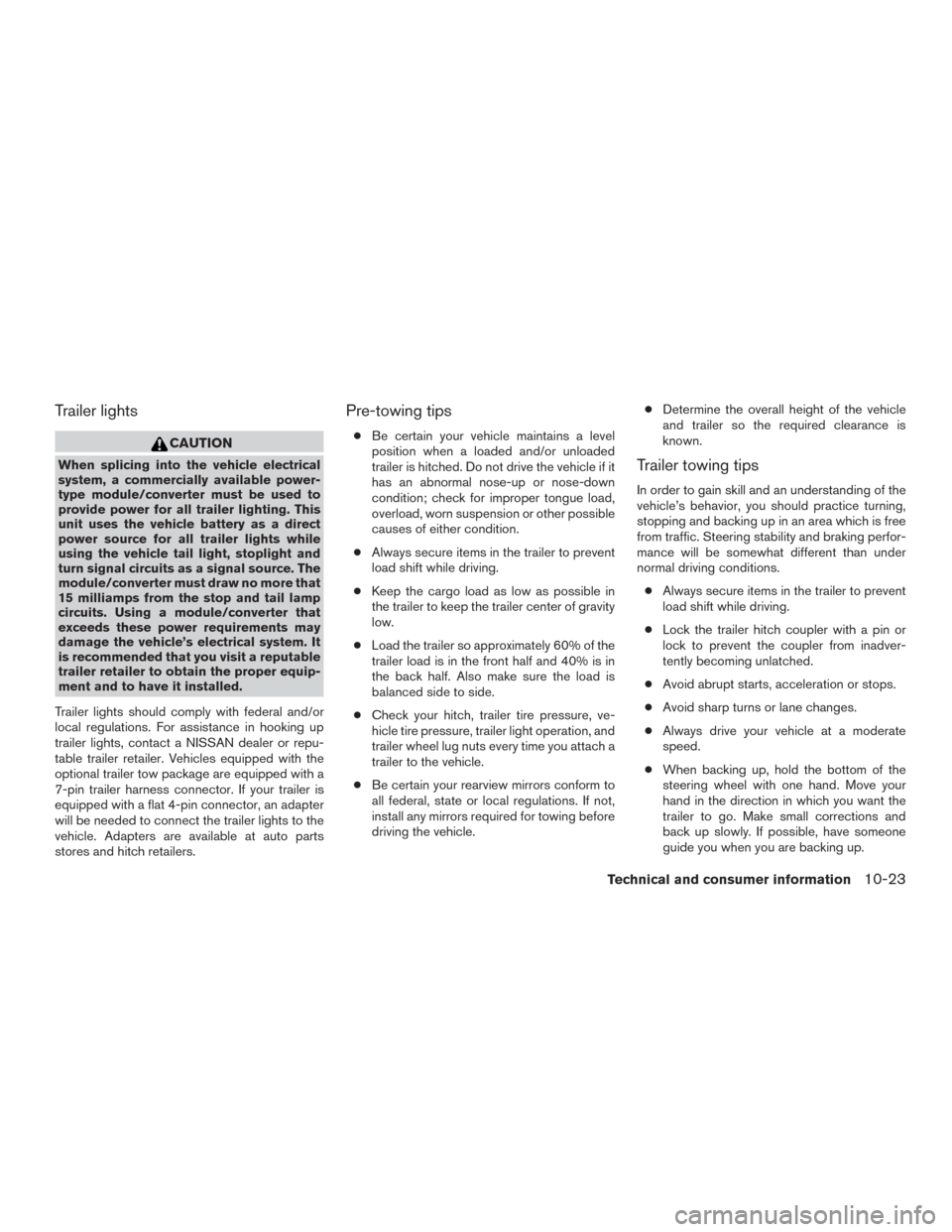
Trailer lights
CAUTION
When splicing into the vehicle electrical
system, a commercially available power-
type module/converter must be used to
provide power for all trailer lighting. This
unit uses the vehicle battery as a direct
power source for all trailer lights while
using the vehicle tail light, stoplight and
turn signal circuits as a signal source. The
module/converter must draw no more that
15 milliamps from the stop and tail lamp
circuits. Using a module/converter that
exceeds these power requirements may
damage the vehicle’s electrical system. It
is recommended that you visit a reputable
trailer retailer to obtain the proper equip-
ment and to have it installed.
Trailer lights should comply with federal and/or
local regulations. For assistance in hooking up
trailer lights, contact a NISSAN dealer or repu-
table trailer retailer. Vehicles equipped with the
optional trailer tow package are equipped with a
7-pin trailer harness connector. If your trailer is
equipped with a flat 4-pin connector, an adapter
will be needed to connect the trailer lights to the
vehicle. Adapters are available at auto parts
stores and hitch retailers.
Pre-towing tips
● Be certain your vehicle maintains a level
position when a loaded and/or unloaded
trailer is hitched. Do not drive the vehicle if it
has an abnormal nose-up or nose-down
condition; check for improper tongue load,
overload, worn suspension or other possible
causes of either condition.
● Always secure items in the trailer to prevent
load shift while driving.
● Keep the cargo load as low as possible in
the trailer to keep the trailer center of gravity
low.
● Load the trailer so approximately 60% of the
trailer load is in the front half and 40% is in
the back half. Also make sure the load is
balanced side to side.
● Check your hitch, trailer tire pressure, ve-
hicle tire pressure, trailer light operation, and
trailer wheel lug nuts every time you attach a
trailer to the vehicle.
● Be certain your rearview mirrors conform to
all federal, state or local regulations. If not,
install any mirrors required for towing before
driving the vehicle. ●
Determine the overall height of the vehicle
and trailer so the required clearance is
known.
Trailer towing tips
In order to gain skill and an understanding of the
vehicle’s behavior, you should practice turning,
stopping and backing up in an area which is free
from traffic. Steering stability and braking perfor-
mance will be somewhat different than under
normal driving conditions.
● Always secure items in the trailer to prevent
load shift while driving.
● Lock the trailer hitch coupler with a pin or
lock to prevent the coupler from inadver-
tently becoming unlatched.
● Avoid abrupt starts, acceleration or stops.
● Avoid sharp turns or lane changes.
● Always drive your vehicle at a moderate
speed.
● When backing up, hold the bottom of the
steering wheel with one hand. Move your
hand in the direction in which you want the
trailer to go. Make small corrections and
back up slowly. If possible, have someone
guide you when you are backing up.
Technical and consumer information10-23
Page 532 of 547
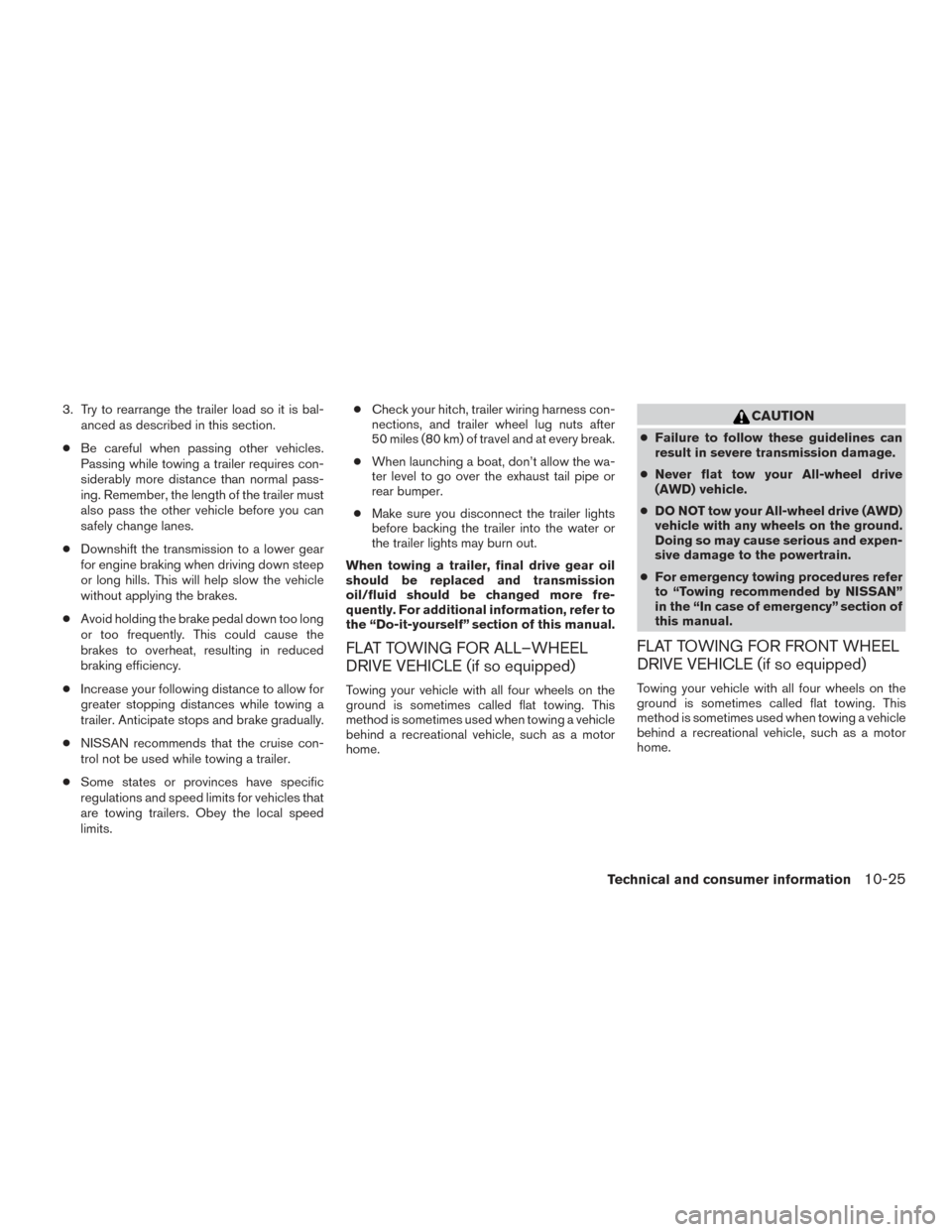
3. Try to rearrange the trailer load so it is bal-anced as described in this section.
● Be careful when passing other vehicles.
Passing while towing a trailer requires con-
siderably more distance than normal pass-
ing. Remember, the length of the trailer must
also pass the other vehicle before you can
safely change lanes.
● Downshift the transmission to a lower gear
for engine braking when driving down steep
or long hills. This will help slow the vehicle
without applying the brakes.
● Avoid holding the brake pedal down too long
or too frequently. This could cause the
brakes to overheat, resulting in reduced
braking efficiency.
● Increase your following distance to allow for
greater stopping distances while towing a
trailer. Anticipate stops and brake gradually.
● NISSAN recommends that the cruise con-
trol not be used while towing a trailer.
● Some states or provinces have specific
regulations and speed limits for vehicles that
are towing trailers. Obey the local speed
limits. ●
Check your hitch, trailer wiring harness con-
nections, and trailer wheel lug nuts after
50 miles (80 km) of travel and at every break.
● When launching a boat, don’t allow the wa-
ter level to go over the exhaust tail pipe or
rear bumper.
● Make sure you disconnect the trailer lights
before backing the trailer into the water or
the trailer lights may burn out.
When towing a trailer, final drive gear oil
should be replaced and transmission
oil/fluid should be changed more fre-
quently. For additional information, refer to
the “Do-it-yourself” section of this manual.
FLAT TOWING FOR ALL–WHEEL
DRIVE VEHICLE (if so equipped)
Towing your vehicle with all four wheels on the
ground is sometimes called flat towing. This
method is sometimes used when towing a vehicle
behind a recreational vehicle, such as a motor
home.
CAUTION
● Failure to follow these guidelines can
result in severe transmission damage.
● Never flat tow your All-wheel drive
(AWD) vehicle.
● DO NOT tow your All-wheel drive (AWD)
vehicle with any wheels on the ground.
Doing so may cause serious and expen-
sive damage to the powertrain.
● For emergency towing procedures refer
to “Towing recommended by NISSAN”
in the “In case of emergency” section of
this manual.
FLAT TOWING FOR FRONT WHEEL
DRIVE VEHICLE (if so equipped)
Towing your vehicle with all four wheels on the
ground is sometimes called flat towing. This
method is sometimes used when towing a vehicle
behind a recreational vehicle, such as a motor
home.
Technical and consumer information10-25
Page 536 of 547
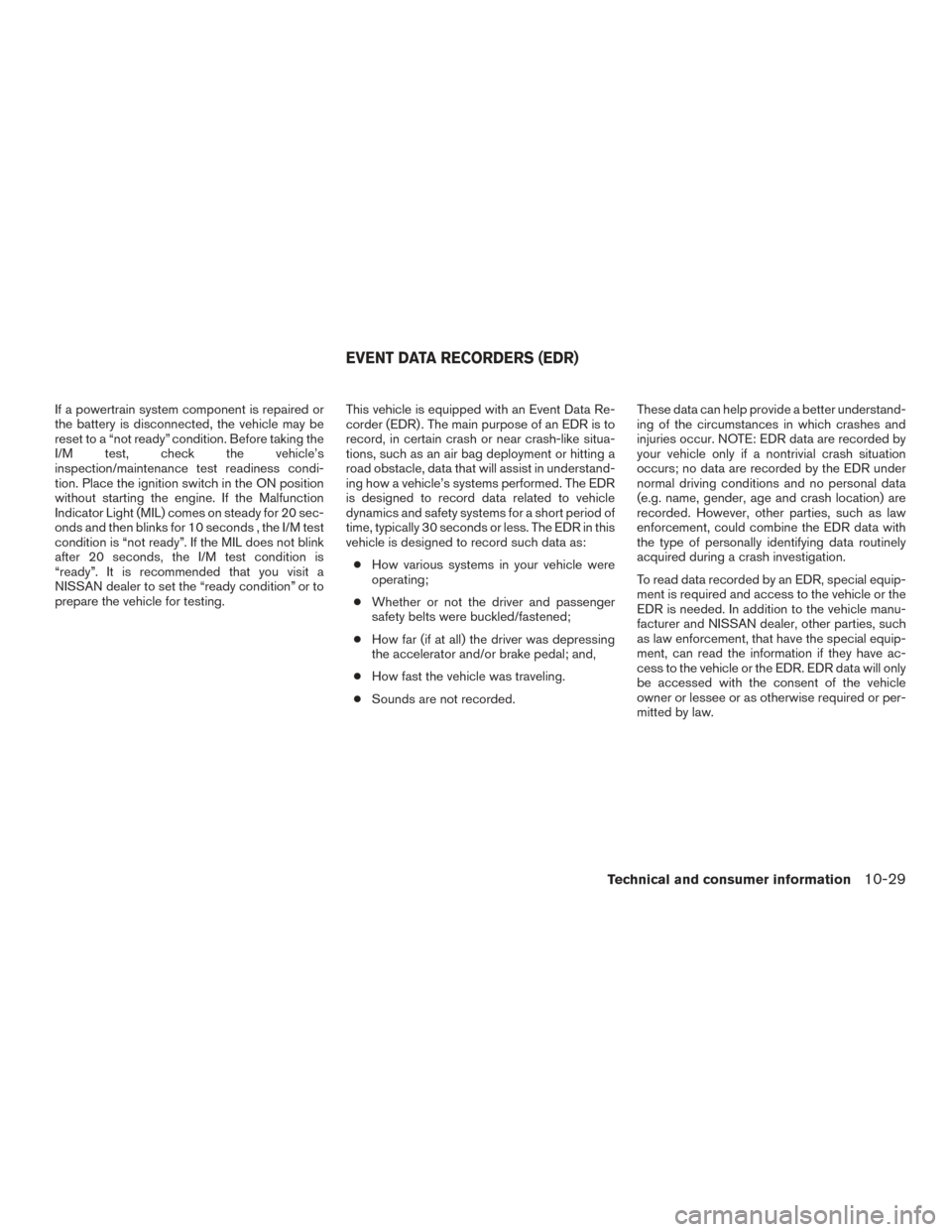
If a powertrain system component is repaired or
the battery is disconnected, the vehicle may be
reset to a “not ready” condition. Before taking the
I/M test, check the vehicle’s
inspection/maintenance test readiness condi-
tion. Place the ignition switch in the ON position
without starting the engine. If the Malfunction
Indicator Light (MIL) comes on steady for 20 sec-
onds and then blinks for 10 seconds , the I/M test
condition is “not ready”. If the MIL does not blink
after 20 seconds, the I/M test condition is
“ready”. It is recommended that you visit a
NISSAN dealer to set the “ready condition” or to
prepare the vehicle for testing.This vehicle is equipped with an Event Data Re-
corder (EDR) . The main purpose of an EDR is to
record, in certain crash or near crash-like situa-
tions, such as an air bag deployment or hitting a
road obstacle, data that will assist in understand-
ing how a vehicle’s systems performed. The EDR
is designed to record data related to vehicle
dynamics and safety systems for a short period of
time, typically 30 seconds or less. The EDR in this
vehicle is designed to record such data as:
● How various systems in your vehicle were
operating;
● Whether or not the driver and passenger
safety belts were buckled/fastened;
● How far (if at all) the driver was depressing
the accelerator and/or brake pedal; and,
● How fast the vehicle was traveling.
● Sounds are not recorded. These data can help provide a better understand-
ing of the circumstances in which crashes and
injuries occur. NOTE: EDR data are recorded by
your vehicle only if a nontrivial crash situation
occurs; no data are recorded by the EDR under
normal driving conditions and no personal data
(e.g. name, gender, age and crash location) are
recorded. However, other parties, such as law
enforcement, could combine the EDR data with
the type of personally identifying data routinely
acquired during a crash investigation.
To read data recorded by an EDR, special equip-
ment is required and access to the vehicle or the
EDR is needed. In addition to the vehicle manu-
facturer and NISSAN dealer, other parties, such
as law enforcement, that have the special equip-
ment, can read the information if they have ac-
cess to the vehicle or the EDR. EDR data will only
be accessed with the consent of the vehicle
owner or lessee or as otherwise required or per-
mitted by law.
EVENT DATA RECORDERS (EDR)
Technical and consumer information10-29
Page 538 of 547

11 Index
2nd row bench seat adjustment.........1-6
A
Aiming control, headlights ........2-43,2-44
Air bag (See supplemental restraint
system) .....................1-46
Air bag system Front (See supplemental front impact
air bag system) ...............1-53
Airbagwarninglabels.............1-63
Airbagwarninglight...........1-64,2-16
Air bag warning light, supplemental . .1-64, 2-16
Air cleaner housing filter ............8-15
Air conditioner Air conditioner operation ..........4-35
Air conditioner specification label ....10-12
Air conditioner system refrigerant and
oil recommendations ............10-7
Air conditioner system refrigerant
recommendations ..............10-7
Heater and air conditioner
controls................4-33,4-41
Servicing air conditioner ..........4-43
Airflowcharts..................4-37
Alarm system
(See vehicle security system) .........2-34
All-Wheel Drive .................5-98
Anchor point locations .............1-30
Antenna .....................4-76
Antifreeze ...................5-111
Anti-lock brake warning light ..........2-12Anti-lock Braking System (ABS)
.......5-103
Apps .......................4-76
Armrests .....................1-6
AroundView®Monitor.............4-17
Audible reminders ...............2-19
Audio system ..................4-43
AMradioreception.............4-44
Bluetooth®audio..........4-72,4-73
Bluetooth® streaming audio ....4-72,4-73
Compact disc (CD) player .....4-55,4-62
FM/AM/SAT radio with compact disc (CD)
player.................4-52,4-57
FMradioreception.............4-44
iPod® Player .............4-67,4-69
iPod® player operation .......4-67,4-69
Radio ....................4-43
USB interface ............4-63,4-65
USB (Universal Serial Bus) Connection
Port..................4-63,4-65
Autolight switch .................2-40
Automatic Automatic drive positioner .....3-41,3-43
Automatic power window switch .....2-63
Automatic anti-glare inside mirror .......3-39
Automatic door locks ..............3-7
Automatic drive positioner .......3-41,3-43
AUXjack ....................4-63
AWD.......................5-98
B
Battery .................5- 111, 8-11Charge warning light
............2-13
Battery replacement ..............8-21
Keyfob ...................8-21
NISSAN Intelligent Key® ......8-23,8-24
Before starting the engine ...........5-18
Belt (See drive belt) ..............8-13
Blind Spot Warning (BSW) warning
system......................5-37
Bluetooth® audio ............4-72,4-73
Bluetooth® hands-free phone
system..................4-81,4-94
Bluetooth® streaming audio with Navigation
System .....................4-73
Boosterseats..................1-43
Brake Anti-lock Braking System (ABS) .....5-103
Brake fluid ..................8-9
Brakelight(Seestoplight).........8-27
Brake system ...............5-103
Brakewarninglight.............2-12
Brakewearindicators........2-19,8-18
Parking brake operation ..........5-25
Self-adjusting brakes ............8-18
Brake assist ..................5-104
Brake fluid ....................8-9
Brakes ......................
8-18
Brake system .................5-103
Break-inschedule ...............5-96
Brightness/contrast button ...........4-10
Brightness control Instrument panel ..............2-45
Bulb check/instrument panel ..........2-11
Bulbreplacement................8-27
Page 539 of 547
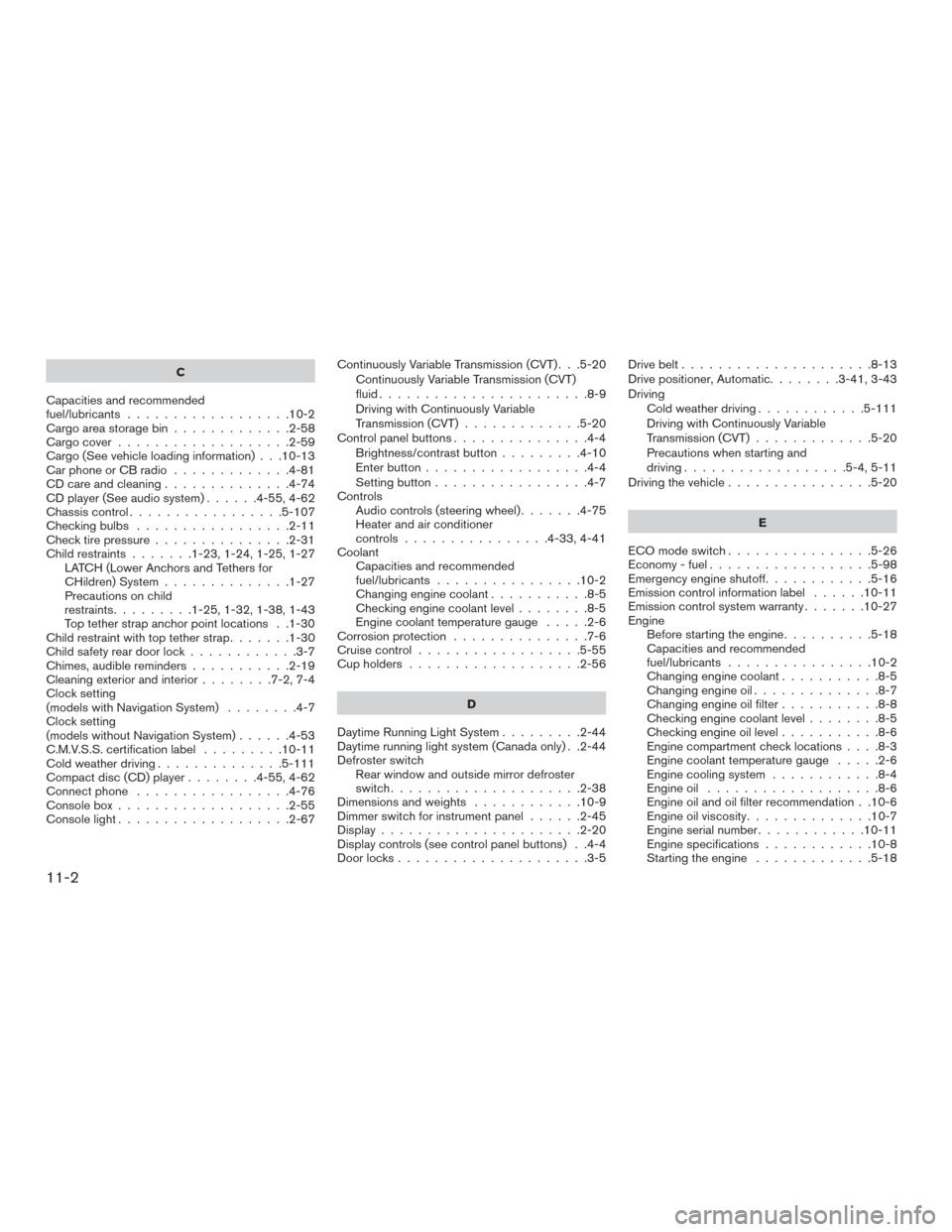
C
Capacities and recommended
fuel/lubricants ..................10-2
Cargoareastoragebin.............2-58
Cargocover...................2-59
Cargo (See vehicle loading information) . . .10-13
Car phone or CB radio .............4-81
CD care and cleaning ..............4-74
CD player (See audio system) ......4-55,4-62
Chassiscontrol.................5-107
Checkingbulbs .................2-11
Check tire pressure ...............2-31
Child restraints .......1-23,1-24,1-25,1-27
LATCH (Lower Anchors and Tethers for
CHildren) System ..............1-27
Precautions on child
restraints.........1-25,1-32,1-38,1-43
Top tether strap anchor point locations . .1-30
Child restraint with top tether strap .......1-30
Child safety rear door lock ............3-7
Chimes, audible reminders ...........2-19
Cleaningexteriorandinterior........7-2,7-4
Clock setting
(models with Navigation System) ........4-7
Clock setting
(models without Navigation System) ......4-53
C.M.V.S.S. certification label .........10-11
Cold weather driving ..............5-111
Compact disc (CD) player ........4-55,4-62
Connect phone .................4-76
Consolebox...................2-55
Consolelight...................2-67 Continuously Variable Transmission (CVT) . . .5-20
Continuously Variable Transmission (CVT)
fluid.......................8-9
Driving with Continuously Variable
Transmission (CVT) .............5-20
Control panel buttons ...............4-4
Brightness/contrast button .........4-10
Enterbutton..................4-4
Setting button .................4-7
Controls Audio controls (steering wheel) .......4-75
Heater and air conditioner
controls................4-33,4-41
Coolant Capacities and recommended
fuel/lubricants ................10-2
Changingenginecoolant...........8-5
Checking engine coolant level ........8-5
Engine coolant temperature gauge .....2-6
Corrosion protection ...............7-6
Cruisecontrol..................5-55
Cupholders...................2-56
D
Daytime Running Light System .........2-44
Daytime running light system (Canada only) . .2-44
Defroster switch Rear window and outside mirror defroster
switch.....................2-38
Dimensionsandweights ............10-9
Dimmer switch for instrument panel ......2-45
Display......................2-20
Display controls (see control panel buttons) . .4-4
Door locks .....................3-5 Drive belt
.....................8-13
Drive positioner, Automatic ........3-41,3-43
Driving Cold weather driving ............5-111
Driving with Continuously Variable
Transmission (CVT) .............5-20
Precautions when starting and
driving ..................5-4,5-11
Driving the vehicle ................5-20
E
ECO mode switch ................5-26
Economy-fuel..................5-98
Emergency engine shutoff ............5-16
Emission control information label ......10-11
Emission control system warranty .......10-27
Engine Before starting the engine ..........5-18
Capacities and recommended
fuel/lubricants ................10-2
Changing engine coolant ...........8-5
Changingengineoil..............8-7
Changing engine oil filter ...........8-8
Checking engine coolant level ........8-5
Checking engine oil level ...........8-6
Engine
compartment check locations ....8-3
Engine coolant temperature gauge .....2-6
Engine cooling system ............8-4
Engineoil ...................8-6
Engine oil and oil filter recommendation . .10-6
Engine oil viscosity ..............10-7
Engine serial number ............10-11
Engine specifications ............10-8
Starting the engine .............5-18
11-2
Page 540 of 547

Engine coolant temperature gauge.......2-6
Enterbutton....................4-4
Event Data recorders .............10-29
Exhaust gas (Carbon monoxide) .........5-4
Explanation of maintenance items ........9-2
Explanation of scheduled maintenance items . .9-5
Extendedstorageswitch ............2-53
Eyeglass case ..................2-55
F
Flashers (See hazard warning flasher switch) . .6-2
Flat tire .......................6-3
Floor mat positioning aid .............7-5
Fluid Brake fluid ...................8-9
Capacities and recommended
fuel/lubricants ................10-2
Continuously Variable Transmission (CVT)
fluid.......................8-9
Engine coolant .................8-4
Engine oil ...................8-6
Windshield-washerfluid...........8-10
F.M.V.S.S. certification label ..........10-11
Foglightswitch .................2-46
Forward Emergency Braking (FEB) .......2-13
Forward Emergency Braking (FEB) with
Pedestrian Detection system ..........5-87
Front air bag system
(See supplemental restraint system) ......1-53
Front power seat adjustment ...........1-4
Frontseats.....................1-2
Fuel Capacities and recommended
fuel/lubricants ................10-2 Fuel economy
................5-98
Fuel-filler door and cap ...........3-35
Fuel gauge ...................2-7
Fuel octane rating ..............10-5
Fuel recommendation ............10-4
Loose fuel cap warning ...........2-31
Fuel efficient driving tips .............5-96
Fuel-filler door ...............3-34,3-34
Fuelgauge.....................2-7
Fuses.......................8-18
Fusiblelinks ...................8-19
G
Garage door opener, HomeLink® Universal
Transceiver ......2-69,2-70,2-71,2-72,2-72
Gascap .....................3-35
Gauge Engine coolant temperature gauge .....2-6
Fuel gauge ...................2-7
Odometer ...................2-5
Speedometer .................2-4
Tachometer ..................2-6
Trip odometer .................2-5
General maintenance ...............9-2
Glovebox.....................2-54
H
Hands-free phone system,
Bluetooth®................4-81,4-94
Hazard warning flasher switch ..........6-2
Headlight aiming control .........2-43,2-44
Headlight and turn signal switch ........2-39Headlightcontrolswitch ............2-39
Headlights....................8-26
Headlights, aiming control
........2-43,2-44
Head restraints ..................1-10
Heated seats ...................2-47
Heated steering wheel switch .........2-48
Heater Heater and air conditioner
controls ................4-33,4-41
Heater operation ...........4-34,4-42
Hill start assist system .............5-110
HomeLink® Universal
Transceiver......2-69,2-70,2-71,2-72,2-72
H
ood.......................3-26
Hook Luggage hook ................2-59
Horn .......................2-46
I
Ignition switch ..................5-13
Ignition Switch Push-Button Ignition Switch ........5-14
Immobilizer system .........2-35,5-14,5-17
Important vehicle information label ......10-11
In-cabin microfilter ................8-15
Increasing fuel economy .............5-98
Indicator lights and audible reminders
(See warning/indicator lights and audible
reminders).................2-12,2-17
Information display ................2-20
Inside automatic anti-glare mirror ........3-39
Instrument brightness control ..........2-45
Instrumentpanel...............0-6,2-2
Instrument panel dimmer switch ........2-45
11-3